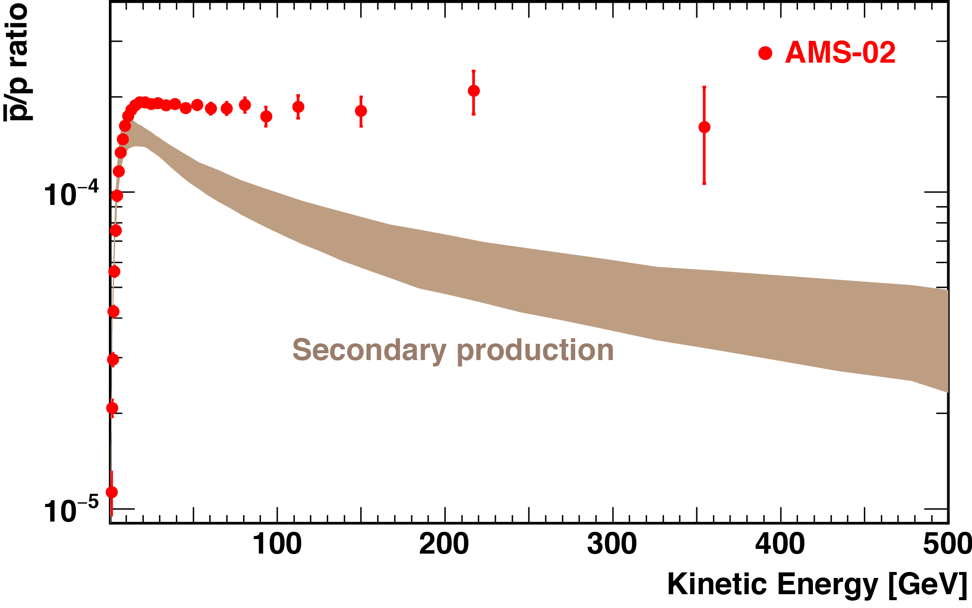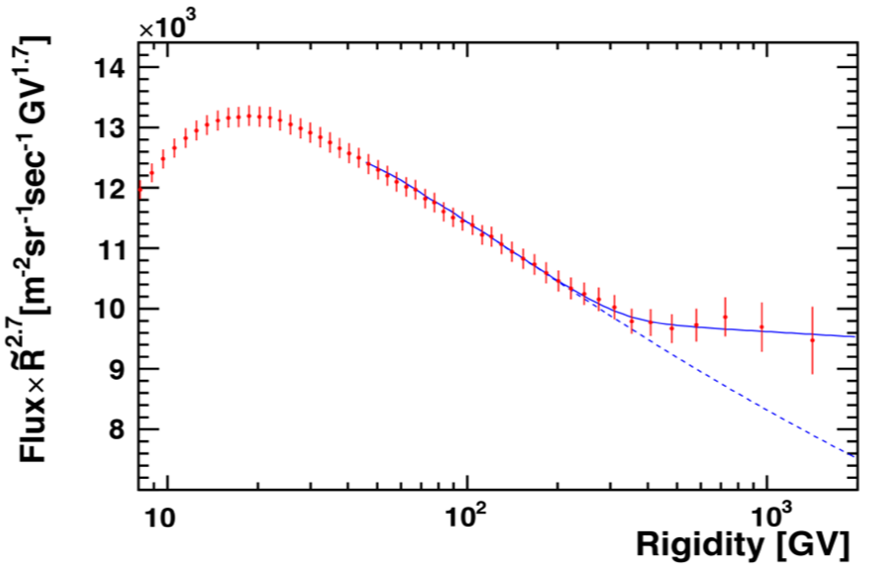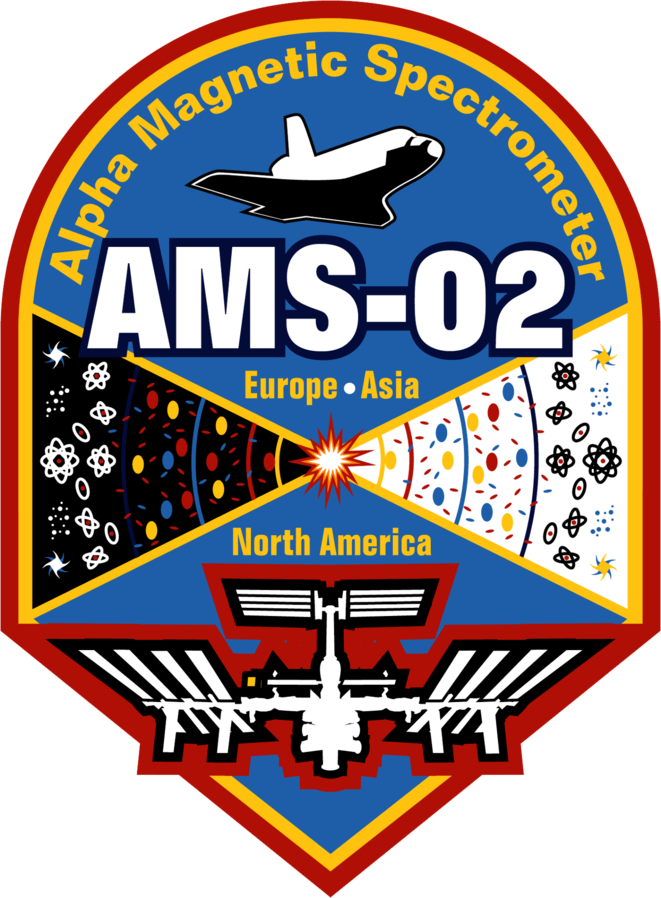New Results From the Alpha Magnetic Spectrometer on the International Space Station
Results from the Alpha Magnetic Spectrometer (AMS) on the International Space Station (ISS) will be the focus of the three day “AMS Days at CERN” meeting, an occasion that brings together many of the world’s leading theoretical physicists and principal investigators of some of the major experiments exploring the field of cosmic ray physics (IceCube, Pierre Auger Observatory, Fermi-LAT, H.E.S.S. and CTA, the Telescope Array, JEM-EUSO, and ISS-CREAM).
The main objective of this scientific exchange is to understand the interrelation between AMS results and those of other major cosmic rays experiments and current theories. The latest results (published and to be published) from AMS will be presented by members of the AMS international collaboration during the three day event.
AMS is the only major particle physics experiment on the ISS. In its first four years on orbit, AMS has collected more than 60 billion cosmic ray events (electrons, positrons, protons, antiprotons, and nuclei of helium, lithium, boron, carbon, oxygen, …) up to multi-TeV energies. As an external payload on the ISS through at least 2024, AMS will continue to collect and analyze an increasing volume of statistics at highest energies which, combined with in-depth knowledge of the detector and systematic errors, will produce valuable insight.
The AMS results on the positron fraction, the electron spectrum, the positron spectrum, and the combined electron plus positron spectrum are consistent with dark matter collisions and cannot be explained by existing models of the collision of ordinary cosmic rays. There are many new models showing that the results may be explained by new astrophysical sources (such as pulsars) or new acceleration and propagation mechanisms (such as supernova remnants).
To distinguish if the observed new phenomena are from dark matter, measurements are underway by AMS to determine the rate at which the positron fraction falls beyond its maximum, as well as the measurement of the antiproton to proton ratio. As seen in Figure 1, the antiproton to proton ratio stays constant from 20 GeV to 450 GeV kinetic energy. This behavior cannot be explained by secondary production of antiprotons from ordinary cosmic ray collisions. Nor can the excess of antiprotons be easily explained from pulsar origin. The latest results on these studies will be reported by the AMS Collaboration during “AMS Days at CERN” and in future publications.
In addition, a thorough understanding of the process involved in the collision of ordinary cosmic rays is a requirement in understanding the AMS results mentioned above. The AMS Collaboration will also report on the most recent results on the precision studies of nuclei spectra (such as protons, helium and lithium) up to multi-TeV energies.
The latest data on the precision measurement of proton flux in cosmic rays from 1 GV to 1.8 TV rigidity (momentum/charge) will appear shortly in Physical Review Letters. These results are based on 300 million proton events. AMS has found that the proton flux is characteristically different from all the existing experimental results. As seen in Figure 2, the AMS result shows the measured flux changes its behavior at ~300 GV rigidity. The solid line is a fit to the data. The dashed line in Figure 2 is the proton flux expected with no change in behavior; as seen, it does not agree with the data.

Most surprisingly, AMS has also found, based on 50 million events, that the helium flux exhibits nearly identical and equally unexpected behavior as the proton flux (see Figure 3). AMS is currently studying the behavior of other nuclei in order to understand the origin of this unexpected change.
These unexpected new observations provide important information on the understanding of cosmic ray production and propagation.
The latest AMS measurements of the positron fraction, the antiproton/proton ratio, the behavior of the fluxes of electrons, positrons, protons, helium, and other nuclei provide precise and unexpected information. The accuracy and characteristics of the data, simultaneously from many different types of cosmic rays, require a comprehensive model to ascertain if their origin is from dark matter, astrophysical sources, acceleration mechanisms or a combination.


Speakers at “AMS Days at CERN” include leaders from the following experiments:
IceCube. IceCube is a particle detector that observes the cosmos from deep within the South Pole ice. IceCube studies the properties and interactions of high energy neutrinos (massless subatomic particles) as well the nature of dark matter and other physical and astrophysical processes. It is the only particle detector of its kind, within a cubic kilometer of ice, to observe and explore the cosmos and has made fundamentally important observations. Results will be presented by the IceCube Neutrino Observatory Principal Investigator, Professor Francis Halzen of the University of Wisconsin.
Pierre Auger Observatory. The Pierre Auger Observatory studies ultra high energy cosmic rays (those with energies above $10^18$ eV) from a 1600 particle detector array covering 3000 square kilometers (an area ~ten times the size of Paris) located in western Argentina. A second array of fluorescence detectors (developed by the University of Utah Cosmic Ray group) utilize clusters of light sensors to measure the cosmic ray’s direction and type of cosmic ray as determined by the light produced in cosmic ray showers. Together, this detection system is a powerful tool in measuring the rare and extraordinarily high-energy cosmic rays from a ground based observatory. The Auger experiment has made many important discoveries in anisotropy as well as the characteristics and behavior of very high energy cosmic rays. Results from the Pierre Auger Experiment will be presented by one of the founders and spokesmen emeritus of the Auger Observatory, Professor Alan Watson of the University of Leeds.
Fermi-LAT. The Large Area Telescope (LAT), a space based high-energy gamma ray telescope, is the main component on the Fermi Gamma Ray Space Telescope spacecraft. Fermi-LAT measures energetic light rays from about 20 MeV to more than 300 GeV as it scans the entire sky every three hours as it orbits the Earth. This powerful instrument studies neutron stars, black holes as well as searches for signatures of dark matter in the diffuse radiation. It continues to provide many important discoveries such as on gamma ray sources. Results from Fermi-LAT will be presented by the Fermi-LAT Principal Investigator, Professor Peter Michelson of Stanford University.
H.E.S.S. and CTA. The High Energy Stereoscopic System (H.E.S.S.) is an array of large imaging atmospheric Cherenkov telescopes located in Namibia for the study of very high energy gamma ray astrophysics. H.E.S.S. has made important discoveries of many gamma ray sources including a new source class and source catalog. CTA (Cerenkov Telescope Array) is an advanced facility for ground based gamma ray astronomy that will continue the work of H.E.S.S. covering a broader energy range, etc. Results from H.E.S.S. and the progress of CTA will be presented by the Project Head, and CTA Spokesman, Professor Werner Hofmann of the Max-Planck-Institut fur Kernphysik in Heidelberg.
Telescope Array. The Telescope Array observes cosmic rays with energies greater than 1018 eV and is spread over 300 square miles of the Utah desert. Using a combination of ground array and air-fluorescence techniques, the experiment observes air showers induced by cosmic rays with extremely high energy. Currently, an extension called TALE (Telescope Array Low Energy Extension) is being implemented which will enable the study of changes in the energy spectrum and chemical composition over a broader energy range. Results from the Telescope Array will be presented by Professor Masaki Fukushima of the University of Tokyo.
JEM-EUSO. The objective of the Extreme Universe Space Observatory (EUSO) is to use a large portion of the Earth’s atmosphere to observe brief flashes of light from deep space caused by the collision of extremely high energy particles (above $10^19$ eV) with a nucleus of an air atom in the atmosphere. The resulting fluorescent UV will be tracked and the position and energy of the shower will be accurately measured creating a time-segmented image of this cosmic scale event. JEM-EUSO follows in the tradition of the successful Pierre Auger Observatory and is currently planned to be launched in the 2017 timeframe and mounted on the Japanese Experiment Module (JEM) on the ISS. The JEM-EUSO program will be presented by the Principal Investigator, Professor Piergiorgio Picozza of INFN, Rome Tor Vergata as well as Professor Angela Olinto, Principal Investigator U.S. Collaboration in JEM-EUSO, of the University of Chicago.
ISS-CREAM. The Cosmic Ray Energetics and Mass (CREAM) Experiment has flown 161 days over the course of six balloon flights over Antarctica. Results indicated a spectral hardening which contradicted the traditional view that simple power law can represent cosmic rays without deviations below the “knee” around $3 x 10^15$ eV where the cosmic ray spectrum steepens. A modified version of the CREAM detector is planned to be mounted on the Japanese Experiment Module (JEM-Kibo) of the ISS. This will significantly improve the energies and statistics of CREAM and will enhance the experiment’s objectives of understanding the origin, acceleration and propagation of cosmic rays. CREAM will be presented by the Principal Investigator, Professor Eun-Suk Seo of the University of Maryland.
“AMS Days at CERN” will also include presentation from a distinguished group composed of some of the world’s leading theoretical physicists.
These include Professors K. Blum of the Institute for Advanced Studies, J. Ellis of King’s College, J.L. Feng of the University of California, Irvine, G. Kane of the University of Michigan, I. Moskalenko of Stanford University, V.S. Ptuskin of IZMIRAN, Moscow, L. Randall of Harvard University, S. Sarkar of Oxford University and Niels Bohr Institute, and T. Slatyer of the Massachusetts Institute of Technology.
The meeting will also feature presentations by leaders from CERN, Professors R. Heuer and F. Zwirner (also Padova), and from government agencies including the President of the Italian Space Agency, R. Battiston (also Trento), by Dr. M. Salamon of the U.S. Department of Energy, and Professor Y. L. Wu of the Chinese Academy of Science. In addition, public lectures will be presented by NASA’s Associate Administrator Mr. W. Gerstenmaier on Human Space Exploration and by Professor Edward Stone of Caltech on the Odyssey of Voyager.
“AMS Days at CERN” takes place from April 15-17, 2015 in the CERN Main Auditorium and is supported by CERN and the University of Geneva.
